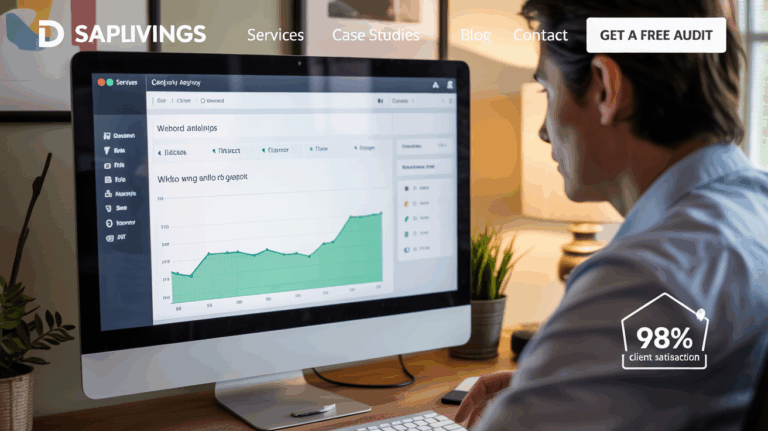Content Marketing for SEO: Writing Blogs That Actually Rank
Optimizing On-Page Elements
Navigating the intricate world of on-page optimization is absolutely vital for boosting those elusive search engine rankings. It’s a dance with elements like title tags, meta descriptions, header tags, and URL structures—each playing its own pivotal role in how search engines decipher content. Crafting unique, keyword-rich title tags isn’t just a technicality; it’s an art form that helps both users and algorithms swiftly grasp the essence of a page’s topic. And let’s not overlook those concise yet compelling meta descriptions—they can skyrocket click-through rates by offering tantalizing glimpses into what lies within.
Header tags? Oh, they should be wielded with intention! They serve to orchestrate your content while seamlessly weaving in relevant keywords. This strategic arrangement doesn’t merely enhance readability; it sends clear signals to search engines about the hierarchy and significance of the information you’re presenting. Plus, there’s another layer—optimizing images through well-thought-out file names and alt text is crucial too! It provides essential context for those diligent little crawlers scouring the web for meaning. When these components come together harmoniously, they create a meticulously structured blog post that stands a much better chance of soaring high in search results!
Key Components to Focus on for SEO Optimization
In the labyrinth of SEO optimization, honing in on specific on-page elements can dramatically elevate a blog’s visibility. Picture this: weaving relevant keywords into title tags and headers, interspersing them throughout your content—this dance helps search engines decipher the very essence of your material. But wait! Crafting captivating meta descriptions is equally vital; these snippets need to be more than mere keyword vessels—they must lure users in with an irresistible allure to click.
And let’s not overlook another game-changer: semantic variations of primary keywords. Think about it—this strategy broadens your reach and boosts the chances of snagging those elusive long-tail search queries that often slip through the cracks.
Now, onto structured data—a crucial cog in this intricate machine. By deploying schema markup, you’re gifting search engines explicit insights into your content’s nature. This enhancement can transform how your blog graces search results, possibly manifesting rich snippets that grab user attention like a moth to a flame!
Page load speed and mobile responsiveness? Oh yes! They wield significant influence over user experience—and consequently, SEO performance as well. A seamless reading journey keeps visitors engaged longer; it reduces bounce rates while sending powerful signals to search engines that your content holds genuine value in the vast digital cosmos.
| SEO Component | Description | Importance |
|---|---|---|
| Title Tags | Incorporates relevant keywords to enhance visibility in search results. | Essential for ranking on search engines and attracting clicks. |
| Meta Descriptions | Brief snippets that summarize content and entice users to click. | Crucial for improving click-through rates (CTR). |
| Semantic Keywords | Incorporating variations of primary keywords for broader reach. | Helps capture long-tail searches and increases content relevance. |
| Schema Markup | Structured data that provides context to search engines about your content. | Can enhance visibility with rich snippets and better search result representation. |
| Page Load Speed | The time it takes for a page to fully load. | Imacts user experience and significantly affects SEO rankings. |
| Mobile Responsiveness | The ability of a website to adapt to various screen sizes. | Increasingly important for SEO as mobile traffic continues to rise. |
Visuals and Their Role in Content Marketing
In the frenetic world of content marketing, weaving visuals into your strategy is not just a good idea—it’s absolutely vital for capturing audience engagement and cementing their retention. Picture this: images, infographics, and videos wield an uncanny power to snag attention far more effectively than mere text can ever hope to achieve. Studies reveal that content peppered with visuals garners significantly higher views, shares, and interactions—it’s practically a no-brainer.
A skillfully crafted image or graphic has the magical ability to transform intricate information into bite-sized morsels that are easy for readers to digest. This visual allure doesn’t merely break up lengthy blocks of text; it beckons visitors to linger longer on the page as they feast their eyes on compelling visuals.
But wait—there’s more! Visuals aren’t just pretty faces in the realm of SEO optimization; they play an instrumental role too. Nowadays, search engines have sharpened their focus on user experience when determining how to rank content. Well-optimized images can catapult visibility in search results by incorporating alt text and file descriptions that enhance accessibility like never before. And let’s not forget video content—a powerhouse in its own right—that boosts those all-important dwell times on pages, sending strong signals to search algorithms about the value of your offerings.
By artfully integrating these visual elements into your blog posts, marketers can elevate both user experience and search performance—turning mundane reading sessions into vibrant journeys through engaging landscapes!
How Images and Videos Enhance SEO
In the ever-evolving landscape of digital content, weaving images and videos into blog entries doesn’t merely enhance user engagement—it transforms it. Imagine a canvas where well-optimized visuals hold visitors captive, extending their stay on a page like moths drawn to light. This increase in time spent sends ripples through search engines, whispering sweet nothings about the content’s inherent value.
But wait! There’s more—the inclusion of alt text isn’t just for accessibility; it’s a golden ticket for keyword integration that can catapult your content up the ranks. Think about it: every image becomes an opportunity waiting to be seized!
And then there are videos—oh, those mesmerizing snippets of motion! They don’t just entertain; they anchor users’ attention, slashing bounce rates and sparking social sharing like wildfire. Search engines have caught onto this trend too; they’re keenly aware that diverse formats make for richer experiences.
Moreover, video platforms such as YouTube have carved out their own niches as search engines themselves. Optimizing titles, descriptions, and tags isn’t simply recommended—it’s essential if you want to boost visibility in this crowded space.
By artfully intertwining images and videos into your strategy, marketers can craft an experience that’s not only dynamic but also magnetic—a siren call to targeted audiences eager to engage with compelling content!
Promoting Your Blog to Increase Reach
The art of distributing blog content effectively is nothing short of vital if you want to cast a wider net and spark genuine engagement. Think about it: social media platforms are like bustling marketplaces where potential readers mingle, eager for interaction that can lead to shares and lively discussions. But here’s the kicker—when you customize your content for each unique audience on these platforms, you’re not just increasing chances; you’re practically rolling out the welcome mat for engagement.
Then there’s email marketing—a powerhouse in its own right! It creates a direct line of communication with subscribers who’ve already shown interest in what you have to say. Imagine reaching out personally, making them feel special as they open your carefully crafted messages.
Let’s not overlook collaboration—teaming up with influencers or fellow bloggers can catapult your visibility into new realms. Guest posts? Oh, they’re golden! Not only do they introduce your voice to fresh audiences, but they also sprinkle some credibility dust over your name within the industry.
And let’s talk dollars: paid promotions through social media ads or search engine marketing allow you to laser-focus on specific demographics. This isn’t just guesswork; analyzing which channels deliver the best bang for your buck is crucial—it’s how you’ll sharpen those promotional strategies moving forward. So gear up and dive into this intricate dance of distribution!
Strategies for Effective Content Distribution
To effectively distribute your content, you must embrace a kaleidoscopic approach that dances across various platforms, each amplifying your reach in unique ways. Social media channels? Absolutely essential! They provide a vibrant stage for direct engagement with your target audience—an electrifying opportunity to spark conversations and cultivate connections. But here’s the twist: crafting content that resonates with the quirks of each platform can significantly boost its visibility. Imagine this: tantalizing snippets from blog posts swirling through Twitter feeds, while visually captivating Instagram Stories serve as alluring teasers leading back to full articles.
And let’s not overlook email newsletters—they’re like golden tickets enabling you to communicate directly with subscribers who have already shown interest in what you create. A crucial lifeline of connection!
But wait, there’s more! Beyond harnessing social media and email marketing’s power, why not join forces with influencers or industry luminaries? Their endorsement can catapult your content into broader realms. Guest posting on niche-relevant websites is another ace up your sleeve; it drives traffic while cementing your authority within the industry.
Don’t forget about SEO-focused outreach strategies—they’re key players too! By enhancing the chances of snagging valuable backlinks, you’ll elevate those search engine rankings higher than ever before. A diverse strategy for distributing content not only expands your reach but also nurtures an engaged community that grows increasingly loyal over time—a true win-win scenario in this bustling digital landscape!
Measuring the Success of Your Blog Posts
Grasping the nuances of blog post performance is essential for fine-tuning content strategies. Metrics like organic traffic, bounce rates, and average time spent on a page unveil intriguing insights into how effectively the material connects with its audience. But wait—there’s more! Keeping an eye on click-through rates (CTR) for those enticing calls-to-action embedded in posts can reveal just how adeptly you’re shepherding readers toward desired actions.
And let’s not overlook engagement metrics; comments and social media shares are telling signs of reader connection—or lack thereof—with your content. Delving into these interactions can unearth patterns that illuminate future topics while enhancing the user experience overall. With tools such as Google Analytics at your disposal, you’re equipped to amass rich data sets that empower content creators to make savvy decisions and optimize strategies for dazzling SEO results!
Metrics to Track for SEO Performance
When diving into the labyrinth of blog post effectiveness for SEO, certain metrics emerge as treasure maps, guiding us to invaluable insights. Organic traffic stands tall as a cornerstone indicator, revealing just how many souls are flocking to your digital abode from the vast seas of search engines. Then there’s keyword rankings—these little nuggets help illuminate the visibility of your content in the bustling marketplace of search results, granting you the power to tweak and refine until those positions ascend.
But wait! The tale doesn’t end there; engagement metrics weave an essential narrative in this quest for success. The bounce rate—a stark figure that tells you what percentage of visitors skedaddle after exploring just one page—serves as a litmus test for your content’s allure and relevance. Moreover, average session duration can paint a vivid picture of how long users linger in your realm, wrapped up in your words. And let’s not overlook conversion rates—they’re pivotal when it comes to gauging how well your content nudges visitors toward taking those coveted actions you desire.
- Monitor click-through rates (CTR) to determine the effectiveness of your titles and meta descriptions.
- Analyze backlinks to understand your site’s authority and the strength of your content.
- Utilize social shares as a measure of how engaging and shareable your content is among your audience.
- Track landing page performance to gauge effectiveness in converting visitors.
- Assess mobile usability metrics, ensuring your site is accessible and functional across devices.
- Review page load times to enhance user experience and reduce bounce rates.
- Keep an eye on search engine visibility to understand how well your site performs against competitors.
Keeping Your Content Updated and Relevant
Keeping your content sharp and on-point is crucial for nailing long-term SEO success. Search engines, those ever-watchful gatekeepers of information, have a soft spot for fresh and enlightening material that taps into current trends and meets the needs of audiences hungry for knowledge. It’s vital to dive back into your existing blog posts regularly—think of it as giving them a little makeover—to make sure the info stays relevant. This could mean slapping on some new data, polishing up outdated stats, or weaving in the latest happenings from your industry tapestry. Not only does this enrich reader experience but it also sends a clear signal to search engines: “Hey! We’re actively nurturing our space here!”
Breathing new life into older content can catapult its visibility in search results like a rocket fueled by curiosity. Search engines often lean towards pages that get spruced up recently—leading to better rankings in their intricate algorithms. Plus, revisiting hot topics gives you the golden opportunity to ride waves of established interest while infusing fresh insights that keep things exciting. This strategy doesn’t just engage first-time visitors; it beckons back loyal readers craving quality content that speaks to their evolving interests and shifting search behaviors—a win-win in every sense!
The Importance of Refreshing Old Content for SEO
Revamping existing content can be a game-changer for your search engine ranking. Picture this: search engines, on the hunt for fresh and relevant nuggets of information, tend to favor those websites that consistently breathe new life into their material. It’s like a dance—this proactive approach not only keeps your facts sharp and trustworthy but also syncs up with the ever-changing interests and inquiries of users out there in the wild web.
Consider giving those old blog posts a facelift! Infuse them with updated stats, sprinkle in some trending keywords, and toss in contemporary examples to spark renewed visibility and engagement. Without regular updates, content risks stagnation—a slow fade into obscurity that can drag organic traffic down along with it. But fear not! By weaving in new insights and optimizing older pieces, you can set their performance ablaze once more; think of it as granting them a second chance at life!
Diligently assessing and refreshing blogs is key—it ensures they continue to be invaluable havens for readers while solidifying authority within your niche. By honing in on this strategy, brands don’t just hold onto their current audience—they open doors wide for newcomers eager for the latest scoop!
Conclusion
Crafting truly effective content marketing strategies isn’t just a nice-to-have; it’s absolutely essential for boosting your SEO game. Imagine this: honing in on those on-page elements like they’re priceless gems, weaving in eye-catching visuals that draw the reader’s gaze, and promoting blog posts with pinpoint precision—these are the tactics that can dramatically elevate online visibility. But wait! It doesn’t stop there; measuring success through key metrics is vital to ensure that your content resonates with the audience while staying ahead of ever-shifting SEO standards.
And here’s the kicker: regularly refreshing and updating existing content does more than keep it fresh—it sends a clear message to search engines that your website is alive and kicking. This dedication to quality isn’t just about maintaining relevance; over time, it can propel rankings skyward. Engaging in an ongoing cycle of analysis and strategy adaptation? That’s where sustainable growth flourishes, leading to a robust online presence you can be proud of!
FAQS
What are the essential on-page elements I should fine-tune for SEO in my blogs?
Ah, the vital components to hone in on! Think title tag, meta description, header tags (H1, H2, H3), URL structure—oh yes—and don’t forget keyword usage and internal linking. Mastering these elements isn’t just a checkbox; it’s your golden ticket to heightened search engine visibility and a delightful user experience.
How do visuals play a role in boosting my blog’s SEO performance?
Visuals—those captivating images and engaging videos—are more than mere decorations! They amplify SEO by ramping up user engagement, slashing bounce rates, and stretching out that precious time visitors spend perusing your page. Plus, when you optimize image alt text and file names? You’re handing search engines the map they need to navigate your content with ease.
What strategies can I employ to effectively promote my blog and widen its audience reach?
Oh, let’s dive into effective promotion tactics! Harness social media platforms like a maestro conducting an orchestra; engage through email marketing that sings directly to subscribers’ hearts; collaborate with influencers who resonate with your brand; tap into guest blogging opportunities like secret doors opening new rooms of potential readers—all while optimizing content for those ever-important search engines to boost organic visibility!
Which metrics should I keep an eye on to gauge the success of my blog posts concerning SEO?
The numbers tell stories worth telling. Keep tabs on organic traffic—a pulse check if you will—bounce rate as a signpost directing attention elsewhere perhaps; average session duration revealing how long folks linger; conversion rates mapping action taken after reading; keyword rankings indicating where you stand in the vast digital landscape alongside social shares showcasing how viral your words have become. Analyzing these figures illuminates both successes and areas ripe for improvement.
Why is it paramount to keep my content fresh and relevant for SEO purposes?
Ahh—the importance of freshness! Regularly updating your content isn’t just beneficial—it’s essential for clinging onto those coveted search engine rankings. By refreshing old pieces regularly, you’re ensuring accuracy prevails while addressing contemporary trends that matter today. This continuous value addition not only enhances reader satisfaction but also steadily elevates overall SEO performance over time!







